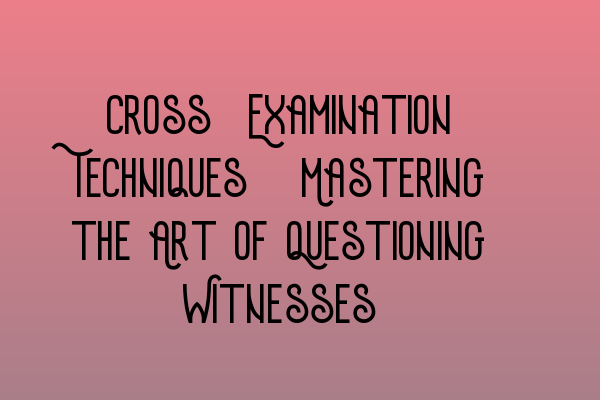Cross-Examination Techniques: Mastering the Art of Questioning Witnesses
As a criminal lawyer, one of the most crucial skills you must possess is the art of questioning witnesses during cross-examination. This powerful technique allows you to challenge the credibility and truthfulness of the witness, expose inconsistencies, and ultimately influence the outcome of the trial. In this blog post, we will explore some essential cross-examination techniques that will help you master the art of questioning witnesses and achieve success in the courtroom.
The Importance of Cross-Examination
Cross-examination is an integral part of any criminal trial. It provides you with the opportunity to challenge the prosecution’s case and weaken their evidence. Effective cross-examination can create doubt in the minds of the jurors or magistrates, thereby increasing the chances of a favorable outcome for your client.
Preparation is Key
Before you step into the courtroom, meticulous preparation is crucial. Familiarize yourself with the witness statements, police reports, and any other relevant documentation. Create a list of the key points you want to address during cross-examination. This will help you stay focused and organized during the questioning.
Establishing Credibility
One of the primary goals of cross-examination is to challenge the credibility of the witness. This can be achieved by questioning their knowledge, biases, and motives. Use leading questions to guide the witness towards your desired answers and expose any inconsistencies in their testimony. Remember to remain polite and professional throughout the questioning process.
Conflicting Accounts and Inconsistencies
During cross-examination, it is essential to identify and exploit any conflicting accounts or inconsistencies in the witness’s testimony. Ask the witness about specific details, times, and locations to reveal any variations in their narrative. Highlight these discrepancies to weaken their credibility and cast doubt on their reliability as a witness.
Controlling the Witness
Controlling the witness during cross-examination is crucial to effectively present your case. Use assertive questioning techniques to guide the witness and prevent them from expanding on their answers or introducing new information. Break down complex questions into smaller, more manageable parts to ensure clarity and minimize the opportunity for the witness to evade or obfuscate.
Active Listening and Non-Verbal Communication
During cross-examination, active listening and non-verbal communication are as important as the questions you ask. Pay attention to the witness’s body language, tone of voice, and facial expressions. These cues can provide valuable insights into their demeanor and truthfulness. Use this information to your advantage to further challenge their credibility and expose weaknesses in their testimony.
Conclusion
Mastering the art of questioning witnesses during cross-examination is a skill that requires practice, preparation, and attention to detail. By employing the techniques discussed in this blog post, you can effectively challenge the credibility and truthfulness of witnesses, weaken the prosecution’s case, and create doubt in the minds of the decision-makers. Remember to stay professional, focused, and always prioritize the best interests of your client. Good luck!
For more information and resources on preparing for the SQE exams, check out our related articles:
